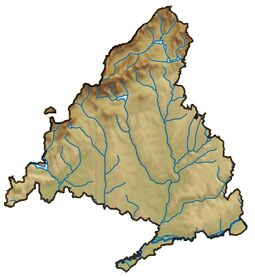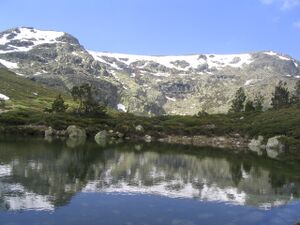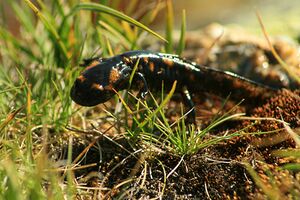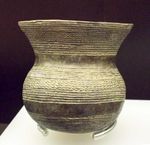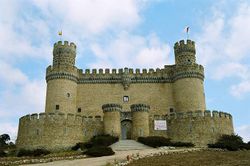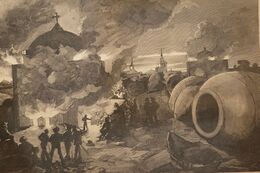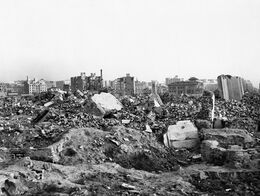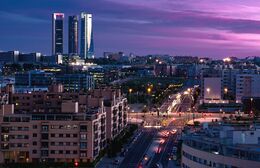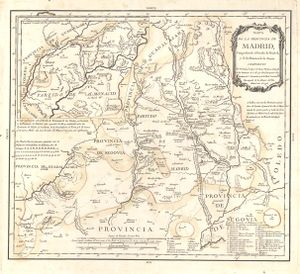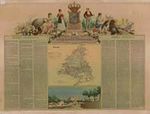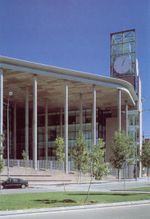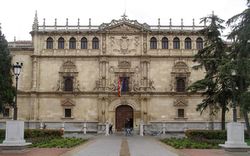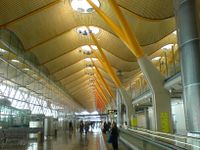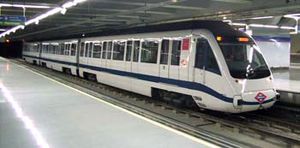مدريد (منطقة ذاتية الحكم)
مدريد | |
|---|---|
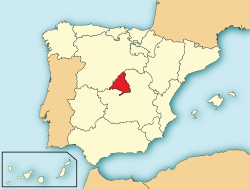 خريطة منطقة مدريد | |
| الإحداثيات: 40°30′N 3°40′W / 40.500°N 3.667°WCoordinates: 40°30′N 3°40′W / 40.500°N 3.667°W | |
| العاصمة | مدريد |
| الحكومة | |
| • الرئيس | Esperanza Aguirre (حزب الشعب) |
| المساحة (1.6% إسپانيا، 12) | |
| • الإجمالي | 8٬030٫1 كم² (3٬100٫4 ميل²) |
| التعداد (2010) | |
| • الإجمالي | 6٬445٬499 |
| • الكثافة | 802٫66/km2 (2٬078٫9/sq mi) |
| • ترتيب السكان | 3 |
| • النسبة | 13٫5% من إسپانيا |
| صفة المواطنة | |
| ISO 3166-2 | M |
| اللغات الرسمية | الإسپانية |
| إعلان الحكم الذاتي | 1 مارس 1983 |
| البرلمان | Cortes Generales |
| Congress of Deputies (Spain):مقاعد الكونگرس | 35 (of 350) |
| مقاعد الشيوخ | 10 (من 264) |
| الموقع الإلكتروني | Comunidad de Madrid |
منطقة مدريد (بالإنگليزية /məˈdrɪd/;[1] إسپانية: Comunidad de Madrid النطق الإسپاني: [komuniˈðað ðe maˈðɾið])، هي احدى مناطق الحكم الذاتي في إسپانيا. وتقع وسط إسپانيا، وشبه جزيرة إيبريا وهضبة قشتالة الوسطى (مستا الوسطى)]]. وعاصمتها هي مدينة مدريد، التي هي أيضاً عاصمة البلد. منطقة مدريد تشترك في حدودها أيضا مع مقاطعة مدريد عاصمة إسپانيا والتي تعتبر أيضا عاصمة للمنطقة. يحدها من الجنوب إلى الشمال كاستيا-لا منتشا ومن الشمال إلى الغرب قشتالة وليون.
منطقة مدريدي هي ثالث أكبر مناطق اسبانيا تعداداً، إذ يبلغ عدد سكانها 6,661,949 نسمة (2019) ويتركز معظمهم في المنطقة الحضرية.[2] It is also the most densely populated autonomous community. In absolute terms, Madrid's economy is, since 2018, slightly bigger in size to that of Catalonia.[3] Madrid has the highest GDP per capita in the country.[4]
The region contains three World Heritage Sites: the Monastery and Royal Site of El Escorial, the University and historic centre of Alcalá de Henares, and the cultural landscape of Aranjuez. In addition, the Montejo Beech Forest is part of the transnational Ancient and Primeval Beech Forests of the Carpathians and Other Regions of Europe world heritage site.
. . . . . . . . . . . . . . . . . . . . . . . . . . . . . . . . . . . . . . . . . . . . . . . . . . . . . . . . . . . . . . . . . . . . . . . . . . . . . . . . . . . . . . . . . . . . . . . . . . . . . . . . . . . . . . . . . . . . . . . . . . . . . . . . . . . . . . . . . . . . . . . . . . . . . . . . . . . . . . . . . . . . . . . .
الجغرافيا
Despite the existence of a large city of 5 million people, the Community of Madrid still retains some remarkably unspoiled and diverse habitats and landscapes. Madrid is home to mountain peaks rising above 2,000 m, holm oak dehesas and low-lying plains. The slopes of the Guadarrama mountain range are cloaked in dense forests of Scots pine and Pyrenean oak. The Lozoya Valley supports a large black (monk) vulture colony, and one of the last bastions of the Spanish imperial eagle in the world is found in the Park Regional del Suroeste in dehesa hills between the Gredos and Guadarrama ranges. The recent possible detection of the existence of Iberian lynx in the area between the Cofio and Alberche rivers is testament to the biodiversity of the area. Taking advantage of the orography, there are several reservoirs and dams in the region, with the Santillana reservoir being the largest.
When looking at a map of the Province of Madrid, it can be seen that it is almost an equilateral triangle, in whose center would be the city. First, by the western side, the region borders the "Sistema Central" (the Guadarrama mountain range), the southern border features a protrusion following the Tagus River in order to include the royal site of Aranjuez in the region; the eastern edge of the triangle comes from the rupture of the fluvial river basins. The region is located in the basin of the Tagus River. The Tagus passes through the southern border of the region in its path west toward the Atlantic Ocean, draining the waters of the Jarama River (collecting in turn the waters of the Lozoya, the Guadalix, the Manzanares, the Henares and the Tajuña), the Alberche and the Guadarrama in the region.[5]
The region also includes the exclave of Dehesa de la Cepeda (part of the municipality of Santa María de la Alameda), a mostly open-area geographically located between the provinces of Ávila and Segovia in the autonomous community of Castile and León.
Province of Madrid occupies a surface area of approximately 8,028 km2 (3,100 sq mi) (1.6% of all Spanish territory). More specifically, the exact position of Madrid is 3° 40´ of longitude west of Greenwich, England, and 40° 23´ north of the equator.
Most of province lies between 600 and 1,000 m above sea level. However, there the altitude ranges from the 2,428 metres of Peñalara and the 430 metres of the Alberche river when it leaves Villa del Prado into the province of Toledo.[6] Other considerable heights, as well as being famous, are the Bola del Mundo ("Ball of the World") in Navacerrada, at a height of 2,258 m, the Siete Picos ("Seven Peaks") in Cercedilla, at 2,138 m, and the Peña Cebollera (2,129 m) at the northernmost end of the province, a tripoint between the Madrid region and the provinces of Segovia and Guadalajara.
- Fauna
Among the protected species of birds nesting in the region stand out the Spanish imperial eagle, the golden eagle, the Bonelli's eagle, the cinereous vulture, the peregrine falcon and the black stork.[7]
Exotic invasive species of birds and mammals in the region include the red-eared slider, the monk parakeet, the common snapping turtle, the rose-ringed parakeet, the American mink and the raccoon.[8] Species described as "out of place" and with an increasing population include the black-headed gull, the lesser black-backed gull, the great cormorant and Eurasian collared dove,[9] while the emblematic iberian ibex is presented as a case of a species "gone out of control" in La Pedriza following its re-introduction in the region in 1990 after roughly a century disappeared from the Madrilenian mountains.[10]
The mountain amphibians living at a high altitude include the fire salamander, the marbled newt, the alpine newt, the iberian frog, the European tree frog or the common midwife toad.[11] At a middle elevation in the mountain reaches close to water streams there are species such as the Bosca's newt, the southern marbled newt, the mediterranean tree frog or the iberian midwife toad.[12] The common parsley frog and the Alytes obstetricans pertinax dwell in the limestone lowlands near the Tagus in the south-east of the region.[12] Among the all-around amphibians adaptable to different heights stand out the natterjack toad, the common toad and the iberian green frog.[12] Other species with a wide distribution range (although in this case restricted by altitude) are the gallipato, the iberian spadefoot toad, the iberian painted frog, and the Spanish painted frog.[12]
Regarding the reptiles, species such as the Cyren's rock lizard, the European wall lizard, the iberian emerald lizard, the deaf adder or snakes such as the smooth snake or the Vipera latastei dwell in the mountain heights.[13] At the lower reaches of the mountains the European pond turtle and the Brediaga's skink can be found, while the western false smooth snake is restricted to areas in the south of the region.[14] Among the species of all-around reptiles, adaptable to different biomes stand out the Spanish pond turtle, the salamanquesa, the western three-toed skink, the spiny-footed lizard, the ocellated lizard, the Algerian sand racer, Spanish psammodromus, the ubiquitous iberian wall lizard, the iberian worm lizard, the Coronella girondica, the Montpellier snake; grass snake and the viperine snake.[15]
The fish species are affected by the high number of reservoirs in the region.[5] Among the threatened species in the rivers stand out the European eel, the iberian barbel, the Squalius alburnoides, the Cobitis calderoni and, potentially, the Chondrostoma lemmingii.[16] Conversely the set of invasive species of fish includes pike, black bullhead catfish, pumpkinseed, zander, common bleak and black-bass.[16]
- Vegetation
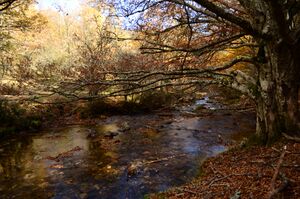
In the vicinity of the mountain peaks, oromediterranean vegetation such as Agrostis truncatula, es (Armeria caespitosa), es (Festuca indigesta), es (Jasione crispa), es (Jurinea humilis), Minuartia recurva, Pilosella vahlii, Plantago holosteum and the Thymus praecox is common.[17] Below the summit line, shrubby species such as the es (Cytisus oromediterraneus) and the common juniper as well as the Scots pine take over.[18] There are also masses of black pine and the pyrenean oak situated above the domain of the holm oak.[19]
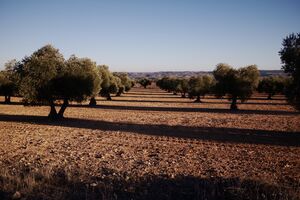
Eurosiberian flora is not common in the region, and species such as the moor birch and the silver birch are restricted to very specific humid valley areas with special climate conditions.[20] The climax vegetation in the campiña is the holly oak. Some of the species that take over when the holly oak forest degrades are the "sticky shrub", the es (Retama sphaerocarpa), the French lavender, the Thymus mastichina and the Thymus zygis.[21]
The lower reaches of Guadarrama Mountain Range are populated by species such as the Juniperus thurifera, the maritime pine, the Portuguese oak, the stone pine; only in the somewhat more humid westernmost end of the region, near the es (Alto del Mirlo), there are forests of chestnut tree.[22]
54,4% of the surface of the region is soil categorised as forest areas of which the 51.4% (27.7% of the total of the region) it is already covered by forests, so there is room for tree re-population.[23] The first modest efforts towards tree re-population were taken in the Lozoya Valley in the late 19th century intending to achieve a purer water from the river,[24] that provided the capital with water for consumption. However the bulk of the process took place after the Spanish Civil War, with a largely successful repopulation with several species of conifers.[25]
Climate
The Madrid region features a climate marked by dry summers, while average temperature varies with altitude, marking different climate subtypes. Most of the region (including the capital) has a climate intermediate between a hot-summer mediterranean climate (Köppen Csa) and a cold semi-arid climate (Köppen BSk), with a dry summer and a moderate to low amount of rain primarily distributed throughout the rest of the year (in the case of the capital, roughly an equinoctial pattern of precipitation maximums), as well as summer temperature averages over 22 °C (with daily maximums consistently surpassing 30 °C in July and August). The areas at a higher altitude close to the Sierra de Guadarrama feature a colder climate, also generally with more precipitation (particularly in the winter), with climate subtypes ranging from the Csa to the warm-summer mediterranean climate (Köppen: Csb) and the dry summer continental climate (Köppen: Dsb) on the peaks of the mountain range, with temperature averages below freezing point during January and February in the later case.
التاريخ
ما قبل التاريخ
The territory of the Community of Madrid has been populated since the Lower Paleolithic, mainly in the valleys between the rivers of Manzanares, Jarama, and Henares, where several archaeological findings have been made.
Some notable discoveries of the region the bell-shaped vase of Ciempozuelos (between 1970 and 1470 BCE),[26] from the Bell beaker culture.
Romans and visigoths
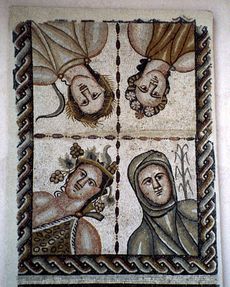
During the Roman Empire, the region was part of the Citerior Tarraconese province, except for the south-west portion of it, which belonged to Lusitania. It was crossed by two important Roman roads, the via xxiv-xxix (joining Astorga to laminium and via xxv (which joined Emerita Augusta and Caesaraugusta), and contained some important conurbations. The city of Complutum (today Alcalá de Henares) became an important metropolis, whereas Titulcia and Miaccum were important crossroad communities.
During the period of the Visigothic Kingdom, the region lost its importance. The population was scattered amongst several small towns. Complutum was designated the bishopric seat in the 5th century by orders of Asturio, archbishop of Toledo, but this event was not enough to bring back the lost splendor of the city.
الأندلس
The centre of the peninsula (the Middle Mark of Al-Andalus or aṯ-Ṯaḡr al-Awsaṭ) became a strategic military post in the 11th century. The Muslim rulers created a defensive system of fortresses and towers all across the region with which they tried to stop the advance of the Christian kingdoms of the north.
The fortress of Mayrit (Madrid) was built somewhere between 860 and 880 AD, as a walled precinct where a military and religious community lived, and which constituted the foundation of the city. It soon became the most strategic fortress in defense of the city of Toledo above the fortresses of Talamanca and Qal'-at'-Abd-Al-Salam (Alcalá de Henares). In 1083 (or 1085) Alfonso VI took the city of Madrid in the context of his wider campaign to conquer Toledo.[27] Alcalá de Henares fell in 1118 in a new period of Castilian annexation.
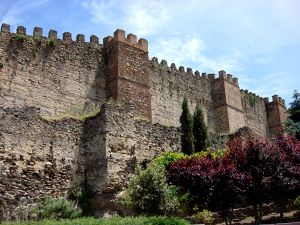
إعادة الاعمار المسيحي
The recently conquered lands by the Christian kingdoms were desegregated into several constituencies, as a consequence of a long process of repopulation that took place over the course of four centuries. The feudal and ecclesiastical lords came into constant conflict with the different councils that had been granted the authority to repopulate.
In the 13th century, Madrid was the only town of the current-day region that preserved its own juridical personality,[بحاجة لمصدر] at first with the Old Fuero (Charter) and later with the Royal Fuero, granted by Alfonso X of Castile in 1262 and ratified by Alfonso XI in 1339. On the other hand, the town of Buitrago del Lozoya, Alcalá de Henares and Talamanca de Jarama, which were rapidly repopulated until that century, were under the dominion of the feudal or ecclesiastical lords. Specifically, Alcalá de Henares was under the hands of the archbishopric of Toledo and remained so until the 19th century.
Around the town of Madrid, an administrative territory was created known as Tierra de Madrid (Land of Madrid), the origin of the province that included the areas of the current municipalities of San Sebastián de los Reyes, Cobeña, Las Rozas de Madrid, Rivas-Vaciamadrid, Torrejón de Velasco, Alcorcón, San Fernando de Henares, and Griñón.
Madrid was in constant strife with the powerful council of Segovia, whose jurisdiction extended south of the Guadarrama Mountains; they both fought for the control of the Real de Manzanares, a large comarca (shire) that was finally given to the House of Mendoza.
Castilian monarchs showed a predilection for the center of the peninsula, with abundant forests and game. El Pardo was a region visited frequently by kings since the time of Henry III, in the 14th century. The Catholic Monarchs started the construction of the Royal Palace of Aranjuez.[محل شك][28] In the 16th century, San Lorenzo de El Escorial was built and became another royal site of the province.
Early modern period

The town of Madrid, which was one of the eighteen cities with the right to vote in the Cortes of Castile, was seat of the Courts themselves on several occasions and was the residence of several monarchs, amongst them the emperor Charles I who reformed and expanded the Alcázar or Castle of the city. Alcalá de Henares grew in importance as cultural center since the foundation by the Cardinal Cisneros of its university.
In 1561, King Philip II made Madrid the capital of the Hispanic Monarchy. The surrounding territories became economically subordinated to the town itself, even beyond the present day limits of the Community of Madrid. But it was not a unified region as several lords and churches had jurisdiction over their own autonomous territories.
During the 18th century, the fragmented administration of the region was not solved despite several attempts. During the reign of Philip V, the intendencia was created as a political and administrative division. Nonetheless, the intendencia of Madrid did not fully solve the problem, and the region was still fragmented into several small dominions even though some processes were centralized. This territorial dispersion had a negative effect on its economic growth; while the town of Madrid received economic resources from the entire country as the capital, the surrounding territories—in hands of noblemen or the clergy—became impoverished.
During the eighteenth century, the town of Madrid was transformed through several grandiose buildings and monuments as well as through the creation of many social, economic, and cultural institutions, some of which are still operating. Madrid grew to a population of 156,672 inhabitants by the end of the eighteenth century.
. . . . . . . . . . . . . . . . . . . . . . . . . . . . . . . . . . . . . . . . . . . . . . . . . . . . . . . . . . . . . . . . . . . . . . . . . . . . . . . . . . . . . . . . . . . . . . . . . . . . . . . . . . . . . . . . . . . . . . . . . . . . . . . . . . . . . . . . . . . . . . . . . . . . . . . . . . . . . . . . . . . . . . . .
Province
The current territory of the region was roughly defined with the 1833 reorganization of Spain into provinces promoted by Javier de Burgos, in which the province of Madrid was classified in the region of New Castile (lacking the later any sort of administrative institution at the regional level nonetheless). The government institution at the provincial level was the deputation (diputación). In addition to the former body, another provincial political authority was the civil governor discretionarily designated by the central government. A modest change to the 1833 provincial boundaries that concerned Madrid took place in 1850, when the small municipality of Valdeavero (19 km2), until then part of the province of Guadalajara, joined the province of Madrid.[29]
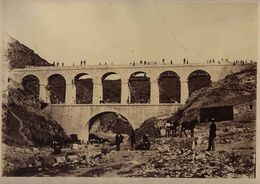
One of the limits so far for the growth of the capital, water supply, experienced a substantial change in 1858 following the arrival to the city of Madrid of water from the Lozoya River with the inauguration of the bringing of the Canal de Isabel II.[30]
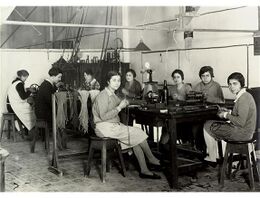
In decadence since the middle 18th century, the city of Alcalá de Henares, experienced a relative demographic and economic upturn in the second half of the 19th century, based on its newly acquired condition of military outpost, to which an embrionary industrial nucleus was also added.[31]
During the reign of Ferdinand VII the south of the province was made up of small agricultural settlements of limited population. Among them, Getafe stood out in population,[32] and became the seat of a judicial district in 1834,[33] with the main economic activity of the former jurisdiction still being non-irrigated agriculture.[33] Rail transport arrived in 1851, with the Strawberry train, the railway connecting Madrid and Aranjuez.
During the Spanish Civil War (1936–1939), the territory was divided by the battlefront, with the southwest of the province controlled by the rebel faction, and the capital as well as a great part of the rest of the province by the side loyal to the Republic. The city of Madrid was target of many bombings during the conflict, becoming the first big city in Europe to suffer such systematic and massive air attacks.[34]
Since the 1970s, a process of a population transfer from the capital to the rest of municipalities of the metropolitan area emerged. This process accelerated when the autonomous community was founded, and it took placed along a strong decrease of birth rates.[35]
Autonomous community
The creation of the contemporary Community of Madrid was preceded by an intense political debate. Autonomous communities were to be created by one or more provinces with a distinct regional identity. Since the 1833 provincial organization, Madrid was part of the historical region of New Castile along with the provinces of Guadalajara, Toledo, Cuenca and Ciudad Real. Thus, it was first planned that the province of Madrid would be part of the future community of Castile–La Mancha (which was roughly similar to New Castile, with the addition of Albacete) but with some special considerations as the home of the national capital.[36] The other provinces that were to become part of the autonomous community of Castile–La Mancha expressed fears of inequality if Madrid were associated with them. These provinces opposed such a special status, and after considering other options for Madrid—like its inclusion in the community of Castile and León or its constitution as an entity similar to a federal district.[36]—it was decided that the province of Madrid would become a single-province autonomous community by virtue of Article 144 of the Constitution, which empowers the Cortes to create an autonomous community in the "nation's interest" even if it did not satisfy the requirement of having a distinct historical identity. Thus, in 1983, the Community of Madrid was constituted and a Statute of Autonomy was approved taking over all the competences of the old "Diputación Provincial" and the new ones the Statute considered.
During the first 25 years of the "autonomic" period, the region accounted for the biggest economic growth in Spain, becoming a platform for the internationalisation of the Spanish economy,[37] featuring a marked preponderance of the service sector.[38] By the turn of the 21st century, a strong boost to the construction sub-sector also took place.[39] During this period the region stood out due to its role as centre for welcoming immigration,[40] due to its condition as transport node vis-à-vis the Spanish geography,[41] and due to its condition as scientific and cultural centre of the country.[42]
مدريد العاصمة
مجتمع و مقاطعة ذاتية الحكم
السياسة والحكومة
مؤسسات الحكومة
انظر: مجلس مدريد انظر: رئيس مدريد
. . . . . . . . . . . . . . . . . . . . . . . . . . . . . . . . . . . . . . . . . . . . . . . . . . . . . . . . . . . . . . . . . . . . . . . . . . . . . . . . . . . . . . . . . . . . . . . . . . . . . . . . . . . . . . . . . . . . . . . . . . . . . . . . . . . . . . . . . . . . . . . . . . . . . . . . . . . . . . . . . . . . . . . .
الانتخابات
الاقتصاد
ديموغرافيا
التعليم
مستويات
الجامعات
النقل
النقل الجوي
قطارات
المترو
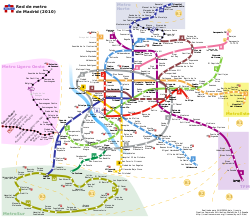
المصادر
- ^ Jones, Daniel (2003), Peter Roach, ed., English Pronouncing Dictionary, Cambridge: Cambridge University Press, ISBN 3-12-539683-2
- ^ "La economía de la Comunidad de Madrid, una de las más potentes y dinámicas del país". Archived from the original on 2009-12-17. Retrieved 2008-04-09.
- ^ "Madrid supera a Catalunya como comunidad con más PIB". La Vanguardia (in الإسبانية). 2019-12-20. Retrieved 2020-05-15.
- ^ PIB por Comunidad Autónoma. Expansion.com. Accessed 31 Julio 2016
- ^ أ ب Gallego Calvo 2011, p. 414.
- ^ Ayllón López & Barbera Luna 2011, p. 58.
- ^ Lara Zabía, Montoro Louvier & Mingot Martín 2011, p. 362.
- ^ Cobos Suárez & Martín Sanz 2011, pp. 88–90.
- ^ Cobos Suárez & Martín Sanz 2011, pp. 90–91.
- ^ Cobos Suárez & Martín Sanz 2011, p. 92.
- ^ Ayllón López & Barbera Luna 2011, p. 59.
- ^ أ ب ت ث Ayllón López & Barbera Luna 2011, p. 60.
- ^ Ayllón López & Barbera Luna 2011, p. 62–63.
- ^ Ayllón López & Barbera Luna 2011, p. 63.
- ^ Ayllón López & Barbera Luna 2011, pp. 63–64.
- ^ أ ب Gallego Calvo 2011, p. 418.
- ^ Grijalbo Cervantes 2011, p. 31.
- ^ Grijalbo Cervantes 2011, p. 32.
- ^ Grijalbo Cervantes 2011, p. 34.
- ^ Grijalbo Cervantes 2011, p. 35.
- ^ Grijalbo Cervantes 2011, p. 39.
- ^ Grijalbo Cervantes 2011, pp. 36–38.
- ^ Sanjuanbenito García 2011, p. 163.
- ^ Sanjuanbenito García 2011, p. 161.
- ^ Sanjuanbenito García 2011, p. 162.
- ^ La Prehistoria en Ciempozuelos Archived 2006-05-11 at the Wayback Machine
- ^ Montoliú Camps 1996, p. 56.
- ^ Brebbia, C. A. (2017-08-30). Water and Society IV (in الإنجليزية). WIT Press. ISBN 978-1-78466-185-4.
- ^ Burgueño 1990, pp. 403; 406.
- ^ Bahamonde Magro & Fernández García 2008, p. 489.
- ^ Gómez Mendoza 2008, pp. 625-628.
- ^ García Alcalá 2008, p. 650.
- ^ أ ب García Alcalá 2008, p. 652.
- ^ Sánchez Pérez 2008, p. 555.
- ^ Fernández García 2008, p. 733.
- ^ أ ب Sid, Blanca. Sinópsis del estatuto de Autonomía de la Comunidad de Madrid Archived 2009-12-11 at the Wayback Machine. Gestión Parlamentaria de la Asamblea de la Comunidad de Madrid. Accessed on: 2008-04-08
- ^ García Delgado & Carrera Troyano 2008, p. 753.
- ^ García Delgado & Carrera Troyano 2008, pp. 756-757.
- ^ García Delgado & Carrera Troyano 2008, pp. 757-758.
- ^ García Delgado & Carrera Troyano 2008, pp. 761.
- ^ García Delgado & Carrera Troyano 2008, pp. 762.
- ^ García Delgado & Carrera Troyano 2008, pp. 763-764.
وصلات خارجية
| Community of Madrid
]].- CS1 الإسبانية-language sources (es)
- Short description is different from Wikidata
- Coordinates on Wikidata
- Pages using infobox settlement with unknown parameters
- Pages using infobox settlement with missing country
- Articles containing إسپانية-language text
- Articles with hatnote templates targeting a nonexistent page
- Articles with unsourced statements from December 2020
- مقالات ذات عبارات محل شك
- منطقة مدريد ذاتية الحكم
- مقاطعات إسپانيا
- مناطق الحكم الذاتي في اسبانيا
- أقاليم التصنيف الأول في الاتحاد الأوروپي
- أقاليم التصنيف الثاني في الاتحاد الأوروپي
- دول وأراضي تأسست في 1983



